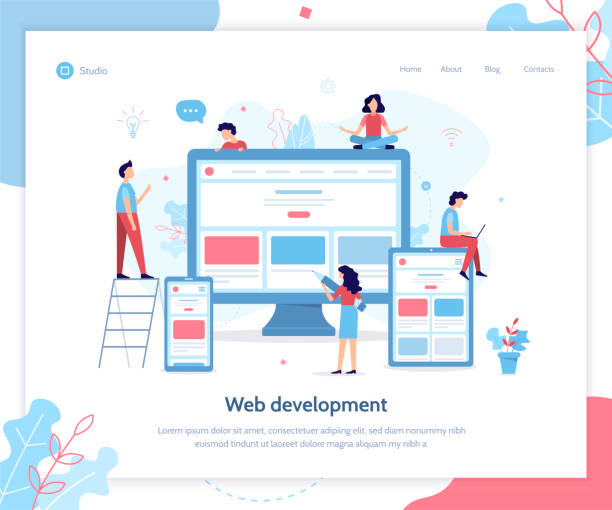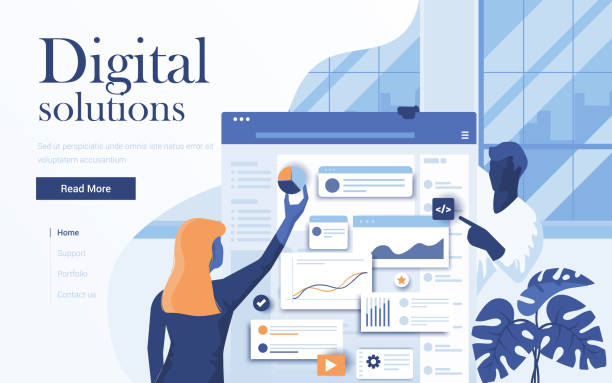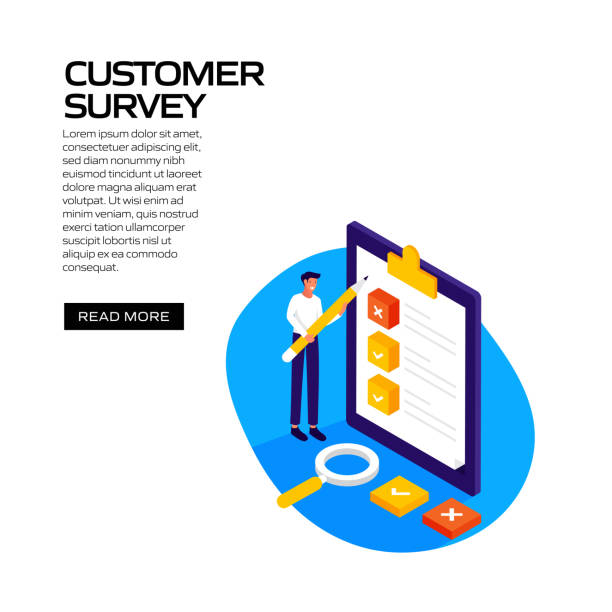Introduction and the Importance of Fast Website Design in Today’s World
![]()
In today’s fast-paced world, speed is paramount.
When it comes to #websites, loading speed is no longer a luxury feature; it’s a vital necessity.
Users expect web pages to open in a fraction of a second, and if not, they simply leave the site.
This abandonment not only leads to losing a visitor but can also negatively impact a site’s #search_engine_ranking and ultimately, brand credibility.
The concept of “fast website design” has gained increasing importance and become a competitive advantage.
This applies not only to technical optimizations but also to how content is produced and even the initial site structure is chosen.
A website that loads quickly provides a better user experience, reduces the bounce rate (Bounce Rate), and increases the conversion rate (Conversion Rate).
Therefore, investing in fast website design is a smart decision for any online business.
Are you dissatisfied with your e-commerce website’s low sales?
Rasaweb is your solution for having a professional and high-selling e-commerce website.
✅ Significant increase in sales and revenue
✅ Easy and enjoyable shopping experience for customers
⚡ Get a free consultation from Rasaweb now!
Factors Affecting Site Speed and Its Technical Aspects

To achieve a high-speed website, identifying the influencing factors is essential.
One of the most important factors is hosting and server quality.
High-performance and fast-responding servers form the foundation of an agile site.
Furthermore, the volume and type of programming codes (HTML, CSS, JavaScript) play a key role; unoptimized and bulky codes can severely reduce loading speed.
Images and videos, if not properly optimized, can also become a bottleneck.
Using appropriate formats, compression, and lazy loading (Lazy Loading) for them is crucial.
The type of framework and Content Management System (CMS) used also impacts speed; some CMSs and plugins are inherently heavier.
Fast website design requires a comprehensive approach that starts with choosing the right infrastructure and extends to optimizing all visual and technical components of the site.
Understanding these specialized factors helps developers make better decisions for website speed optimization.
Website Speed Evaluation and Optimization Tools

To ensure your efforts for fast website design have been fruitful, you need accurate tools for speed evaluation and analysis.
Google PageSpeed Insights is one of the most popular and reliable tools provided by Google, displaying key speed metrics for mobile and desktop.
This tool not only provides a speed score but also offers specific recommendations for improving site performance.
GTmetrix is another tool that displays more details, including a Waterfall Chart, which helps you understand which site resources consume more loading time.
Pingdom Tools is also an excellent option for checking website loading time and overall performance from different locations worldwide.
These tools, by accurately analyzing site codes, images, CSS and JavaScript files, as well as server performance, identify weaknesses and pave the way for further optimizations.
Regular use of these tools allows you to continuously monitor your progress towards achieving fast website design and be informed of any potential speed drops.
This is a vital part of the website optimization process.
Comparison of Website Speed Evaluation Tools
| Tool Name | Key Features | Main Focus |
|---|---|---|
| Google PageSpeed Insights | Performance score, Core Web Vitals, Google optimization recommendations | Google metrics and user experience |
| GTmetrix | PageSpeed and YSlow scores, Waterfall chart, performance history | Deep analysis and technical details |
| Pingdom Tools | Loading time from different locations, page size, number of requests | Loading speed and end-user performance |
Impact of Site Speed on User Experience (UX)

User Experience (User Experience – UX) is the backbone of any website’s success, and site speed is one of its most vital elements.
A fast website design means reducing user wait time, smoother navigation, and ultimately, greater user satisfaction.
When a page loads quickly, the user can access their desired content without interruption, which leads to them spending more time on the site.
Conversely, even a few seconds of loading delay can lead to a significant increase in bounce rate; today’s users quickly get bored and move on to your competitors.
This is particularly important for mobile users who may be using slower internet connections.
A slow website damages your brand’s credibility and gives users the impression that your site is old or unprofessional.
On the other hand, an agile website not only keeps users satisfied but also encourages them to return to your site and interact more, which significantly contributes to improving the conversion rate.
Did you know that 85% of customers check your company’s website before any interaction?
With Rasaweb, build a corporate website worthy of your credibility.
✅ Increase credibility and customer trust
✅ Attract high-quality leads
⚡ Get free website design consultation
Site Speed and Search Engine Optimization (SEO)

The connection between site speed and SEO is no longer a secret.
Google and other search engines consider page loading speed as an important factor in website ranking.
This means that a fast website design can directly impact your position in search results.
Search engines aim to provide the best user experience to their users and know that loading speed plays a key role in this experience.
Slower sites may be visited less frequently by search engine crawlers (a problem known as “crawl budget”), which can lead to delayed or incomplete indexing of your new pages.
Furthermore, site speed indirectly affects SEO; as mentioned earlier, high speed leads to improved user experience, reduces bounce rate, and increases user dwell time on the site.
All these factors send positive signals to search engines, indicating the quality and popularity of your site.
Therefore, website speed optimization is essential not only for your users but also for achieving better rankings in search results.
Practical Methods for Increasing Site Speed: Part One – Caching and CDN

To achieve fast website design, implementing practical and effective methods is essential.
One of the most powerful methods is using caching (Caching).
Caching means temporarily storing a version of website pages or resources (such as images, CSS, JavaScript) in the user’s browser memory or on the server.
This ensures that in subsequent visits, there’s no need to reload all content from the main server, and the site is displayed much faster.
Caching plugins for Content Management Systems like WordPress easily enable the caching process.
Another method is using a CDN (Content Delivery Network).
A CDN is a network of servers in different geographical locations around the world.
When a user visits your site, content is delivered to them from the closest CDN server, which significantly reduces physical distance and server response time.
This technique is particularly effective for sites with global audiences or extensive multimedia content.
By integrating caching and CDN, you can dramatically reduce the load on the main server and provide a fast and stable loading experience for all your users, regardless of their geographical location.
These two strategies form the foundation of site speed optimization.
Practical Methods for Increasing Site Speed: Part Two – Images and Code

Continuing the process of fast website design requires more precise optimization of page components.
Images are often the biggest cause of site slowness.
To address this, images must be properly optimized: use appropriate image formats (such as WebP) which offer better compression, adjust image dimensions to their display location, and use image compression tools to reduce file sizes without significant quality loss.
Furthermore, implementing lazy loading (Lazy Loading) for images and videos is crucial; with this method, multimedia content is loaded only when the user scrolls towards it, not at the initial page load.
The other part concerns site codes.
Minification of CSS and JavaScript files means removing white spaces, comments, and extra characters, which reduces file sizes and helps them load faster.
Concatenation of CSS and JavaScript files can also reduce the number of HTTP requests to the server.
With these methods, you can significantly increase your site’s loading speed and achieve the goal of agile website design.
Image and Code Optimization Techniques
| Technique | Description | Benefit |
|---|---|---|
| Image Optimization | Compression, resizing, using next-gen formats (WebP) | Reduced file sizes, faster visual content loading |
| Lazy Loading | Loading images and videos only when they enter the user’s viewport | Reduced initial page load, improved Core Web Vitals |
| Minification | Removing white spaces and comments from CSS and JavaScript | Reduced code file sizes, faster script loading |
| Concatenation | Combining multiple CSS or JavaScript files into one | Reduced number of HTTP requests to the server |
Challenges and Misconceptions in Fast Website Design

Despite all the advantages of fast website design, this path also comes with challenges and misconceptions.
One of the most common misconceptions is that some believe speed issues are solved merely by purchasing a powerful host, whereas this is only part of the equation.
Inadequate codes, unoptimized images, and heavy plugins can slow down even the best servers.
Another challenge is maintaining a balance between speed and visual appeal or functionality; sometimes web designers use heavy visual effects or too many fonts that enhance the site’s aesthetics but severely reduce its speed.
Finding the right balance between these two aspects requires experience and technical knowledge.
Also, some think that speed optimization is a one-time process, while in reality, it’s an ongoing process.
With the addition of new content, new plugins, or changes in infrastructure, re-optimization may be necessary.
Neglecting mobile user experience is also a common mistake; given the increased use of mobile devices for internet access, website loading speed on mobile devices is of high importance and should be specifically addressed.
Tired of losing customers due to poor e-commerce website design? With Rasaweb, solve this problem forever!
✅ Increase sales and conversion rate from visitor to customer
✅ Smooth and engaging user experience for your customers⚡ Get a free consultation
The Future of Website Design and Speed: Predictions and New Trends

The future of fast website design lies in emerging technologies and changing priorities.
With technological advancements, user expectations also rise, and websites must meet these expectations.
One significant trend is a greater focus on Mobile-First.
Designing and optimizing sites first for mobile devices and then for desktop will become a standard, as the majority of web traffic comes from mobile.
The emergence of technologies like PWAs (Progressive Web Apps), which provide a user experience similar to native applications in the browser, indicates the future direction.
These applications rely on high speed, offline functionality, and notifications.
The use of HTTP/3 and newer communication protocols that improve network performance is also expanding.
Artificial intelligence can also play a significant role in automatically optimizing images, code, and even predicting user behavior for faster content loading.
Finally, the focus on Google’s Core Web Vitals, which include LCP, FID, and CLS metrics, has become a new standard for evaluating user experience and site speed.
These trends indicate that fast website design is constantly evolving and requires continuous updates of knowledge and tools.
Conclusion and the Continuous Importance of Speed Optimization

In conclusion, it can be said that fast website design is no longer an optional choice but a fundamental pillar for success in the digital space.
From improving user experience and reducing bounce rates to achieving better search engine rankings and increasing conversion rates, website speed directly impacts all aspects of an online business’s presence.
As we’ve seen, multiple factors influence site speed, and achieving an agile website requires a comprehensive and multifaceted approach that includes optimizing infrastructure, code, images, and using tools like caching and CDN.
Do not forget that this process is a continuous effort, and with technological changes and user expectations, it requires ongoing review and optimization.
Investing in website speed optimization not only saves time and costs in the long run but also helps you stay one step ahead of your competitors and provide an exceptional user experience to your audience.
Ultimately, successful website design depends on its speed.
Frequently Asked Questions
| Row | Question | Answer |
|---|---|---|
| 1 | What does fast website design mean? | Fast website design refers to the process of launching a functional and optimized website in the shortest possible time, without sacrificing its quality or efficiency. |
| 2 | What factors affect website design speed? | Using ready-made Content Management Systems (CMS) like WordPress, pre-built and optimized templates, visual design tools, designer’s experience, and effective communication with the client. |
| 3 | Does fast website design always mean reduced quality? | No, with proper planning, using optimized tools, and standard techniques, a high-quality website can be designed in a short time. |
| 4 | What types of websites are most suitable for fast design? | Small corporate websites, blogs, online resumes, landing pages, and e-commerce stores with limited products. |
| 5 | What is the role of CMSs (like WordPress) in fast design? | CMSs significantly speed up the design and development process by providing templates, plugins, and an easy-to-use admin panel. |
| 6 | Does fast website design cost less? | Usually, yes. Due to reduced designer work time and the use of ready-made resources, costs can be significantly lowered. |
| 7 | What client information is needed for fast design? | Contact information, logo, textual content, images, website goals, and any specific customization needs. |
| 8 | Can fast-designed websites be developed further in the future? | Yes, especially if built with popular CMSs like WordPress, new features can easily be added to them in the future. |
| 9 | What are the benefits of fast website design for businesses? | Faster market entry, testing new ideas with minimal risk, reduced costs, and the ability to launch immediate marketing campaigns. |
| 10 | What is the difference between fast website design and a ‘ready-made site’? | Fast design involves the process of design and implementation based on client needs, even though it uses ready-made tools. However, a ‘ready-made site’ usually refers to platforms where you only input your information and receive a pre-defined site. |
And other services of Rasaweb Advertising Agency in the field of advertising
Smart Link Building: An effective tool for increasing sales with attractive UI design.
Smart Marketplace: An effective tool for customer acquisition through marketing automation.
Smart Link Building: A professional solution for analyzing customer behavior with a focus on using real data.
Smart Customer Journey Map: Transform digital branding with Google Ads management.
Smart Social Media: A fast and efficient solution for campaign management focusing on user experience customization.
And over hundreds of other services in internet advertising, advertising consultation, and organizational solutions.
Internet Advertising | Advertising Strategy | Sponsored Articles
Sources
IranHost – Standard Website DesignRaykaWeb – Website Design Speed OptimizationSepehr Parvaz – Professional Website DesignNetDanesh – Website Speed Increase
? Are you ready to transform your business in the digital space? Rasaweb Afarin Digital Marketing Agency, with years of experience and expertise in professional website design, SEO, and comprehensive digital strategies, offers innovative solutions for your sustainable growth and success.
📍 Tehran, Mirdamad Street, next to Central Bank, Southern Kazeroun Alley, Ramin Alley, No. 6



